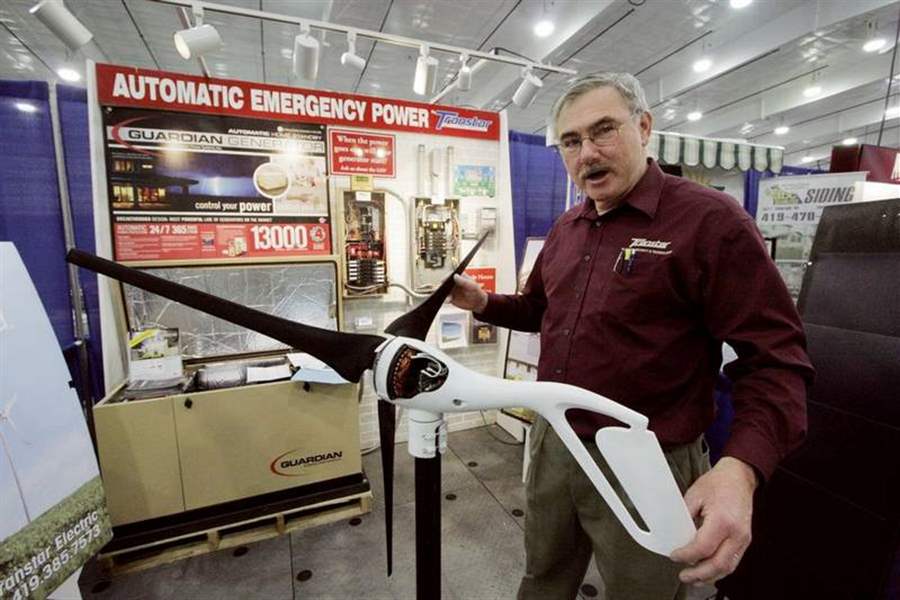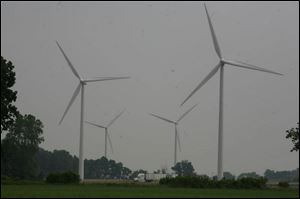
Sylvania hopes wind generates utility savings
5/5/2008
Steve Ash of Sylvania Township, who attended a trade show last month, shows off a wind generator that can produce 500 watts of power. The exhibit was part of the Showcase Sylvania Business Expo at Tom-O-Shanter Sports.

Steve Ash of Sylvania Township, who attended a trade show last month, shows off a wind generator that can produce 500 watts of power. The exhibit was part of the Showcase Sylvania Business Expo at Tom-O-Shanter Sports.
Sylvania City Councilman Michael Brown is tired of seeing his utility bills soar, and he's leading his city on the search for an alternative.
Like a growing number of communities, Sylvania is seeking funding to install sensors that would gauge the power of the breezes floating over the city. If analysis warrants, the city plans to consider financing wind turbines that would generate power and stabilize residents' utility bills.
Public entities throughout the area are following suit. The city of Oregon; Archbold schools; Lenawee County, Michigan, and Northwest State Community College are evaluating their wind potential.
Students at Clay High School in Oregon are building a 45-foot wind turbine. The village of Elmore is looking into acquiring property for a wind farm after a feasibility study was completed there in 2006.
Leading the pack is the city of Bowling Green, home to Ohio's only utility-sized wind farm. Since 2004, the city has been operating four turbines.
Bowling Green obtains more than 16 percent of its power from wind, solar, landfill gas, and other "green" energy sources, said Kevin Maynard, utility director. Its wind turbines generate enough energy to power 1,900 homes.

Bowling Green, which has four wind turbines, is seen as a model for other communities seeking to lower utility costs.
Perhaps more significant, Bowling Green's experiment with wind energy is proving to be a sound investment. The $10 million wind farm, financed over 15 years, produces power to consumers at a rate of about 7 cents per kilowatt hour, Mr. Maynard said.
The rate is "comparable to power we would get from another source," he said.
Rising fossil-fuel prices are attracting private investors to wind as well, said Andrew Solocha, chairman of the University of Toledo's finance and business economics department.
Mr. Solocha is stepping down as finance director to devote himself to wind development. He will continue at the university in a teaching role, while helping entities like Sylvania harness the power of wind.
"I'm looking at it as a strictly money-making operation," Mr. Solocha said. "The people that are putting up windmills, they're not doing it for ecological reasons, it's all about money."
Northwest Ohio's flat lakefront topography makes it ideal for wind farming, Mr. Solocha said.
"We have a large, untapped power source right here," Mr. Solocha said. "There's going to be an explosion of windmills coming in."
Meanwhile, manufacturers can't build windmills fast enough to keep pace with demand, he said.
A recent study showed that Ohio could generate up to 10 percent of its energy with wind, said William Spratley of the nonprofit organization Green Energy Ohio in Columbus.
Northwest Ohio, the region of the state once covered in glaciers, is probably the best positioned region in the state to take advantage of growth in the field, he said.
Mr. Spratley's organization is conducting a study at the Toledo Zoo to determine the feasibility of building a wind farm on the scale of Bowling Green's there.
In a move that could increase incentives for wind developers at the state level, Gov. Ted Stickland signed a bill Thursday that will require power companies to draw 25 percent of their energy portfolio from alternative sources by the year 2025.
Three leading private wind developers have promised to deliver $2.7 billion in investment to the Ohio economy under the new legislation, Mr. Spratley said.
Continuing progress, however, will depend on maintenance of national tax incentives for wind power developers, Mr. Spratley said. Congress may allow the tax incentives to expire, he said.
As much potential as wind holds for the regional economy and the environment, however, the energy source has its limitations, Mr. Solocha said.
"The problem with wind is it isn't windy all the time," he said. "It will be very difficult to get about 20 percent [total power] because of the nature of wind production."
Even in Bowling Green, only about 2 percent of the city's energy is generated with wind, Mr. Maynard said.
That may change soon. Mr. Maynard said the city is hoping to significantly increase the size of its wind farm.
"It has really helped us keep our costs low and stable," Mr. Maynard said.
In Sylvania, it will be at least one year before the city has the results of a study that would determine whether windmills could become a feature in its horizon.
Even if the conditions are favorable, the city will still have to select sites for turbines, develop a financing plan, and manage community concerns. The process often takes 10 years, Mr. Spratley said.
"It's still in the infancy stages right now," Sylvania Councilman Mr. Brown said. "Our concern is where do we put them. I have heard they do make some type of noise."
At the same time, utility bills present a convincing argument for experimentation.
"The rates keep going up and up and up," Mr. Brown said. "I think it's the wave of the future."
Contact Angie Schmitt at:
aschmitt@theblade.com
or 419-724-6104.